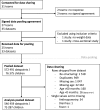Cohort profile: the WHO Child Mortality Risk Stratification Multi-Country Pooled Cohort (WHO-CMRS) to identify predictors of mortality through early childhood
- PMID: 39613436
- PMCID: PMC11605845
- DOI: 10.1136/bmjopen-2024-085164
Cohort profile: the WHO Child Mortality Risk Stratification Multi-Country Pooled Cohort (WHO-CMRS) to identify predictors of mortality through early childhood
Abstract
Purpose: To provide details of a pooled data set that will be used to estimate absolute and relative mortality risks and other outcomes among children less than 59 months of age and the predictive performance of common risk exposures, both individually and in combination.
Participants: Children from birth to 5 years of age recruited at health facilities or community settings into 33 longitudinal observational or intervention studies in 17 low- and middle-income countries.
Findings to date: The data set includes 75 287 children with a median age of 3 months (IQR 1-12) at first measurement. In the pooled sample, 2805 (3.7%) of the study children died. Data on birth weight was recorded in 19 studies, and gestational age in 13 studies. Among these, 14% of the included children were reported as having low birth weight, and 14% had preterm birth. At first measurement, 33% of the children were stunted, 24% were wasted and 35% underweight. 13% and 7% of caregivers reported that their child had acute diarrhoea or acute lower respiratory tract infection before the study visit, respectively. The proportion of children reported as breastfed at any study visit decreased from 99% at age <6 months to 77% in the age group 12-23 months. Child characteristics differed considerably between studies in the community and healthcare settings. The median study period was 15 months (IQR 7.6-18.4 months).
Future plans: Planned analyses will examine knowledge gaps with the aim of informing global guidelines and their derivatives such as clinical management tools and implementation guidance, and to inform future research agendas. We aim to estimate absolute mortality risks associated with child age, anthropometry, birth characteristics and feeding practices as planned by the WHO-Risk Stratification Working Group. In the future, other data sets may be added and further questions on survival and growth will be investigated.
Keywords: EPIDEMIOLOGIC STUDIES; Mortality; PAEDIATRICS; PUBLIC HEALTH; STATISTICS & RESEARCH METHODS.
© Author(s) (or their employer(s)) 2024. Re-use permitted under CC BY-NC. No commercial re-use. See rights and permissions. Published by BMJ.
Conflict of interest statement
Competing interests: None declared.
Figures



References
-
- UN IGME . New York: UNICEF, WHO, World Bank Group; 2022. Levels & trends in child mortality - report 2022.
-
- IHME . Seattle, WA: Institute for Health Metrics and Evaluation; 2014. Pushing the pace: progress and challenges in fighting childhood pneumonia.
MeSH terms
Grants and funding
LinkOut - more resources
Full Text Sources
